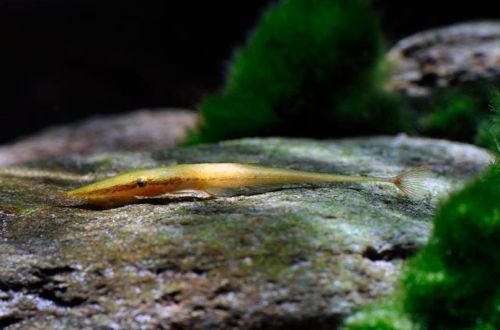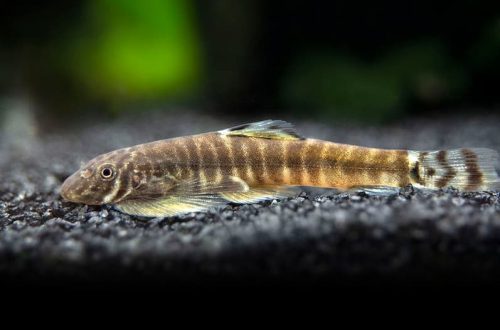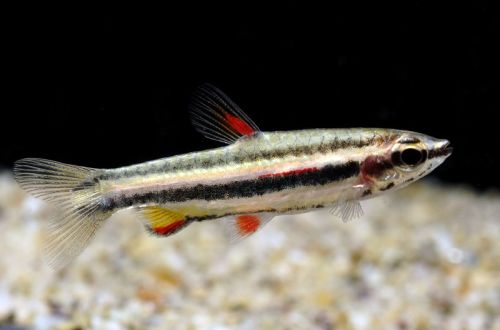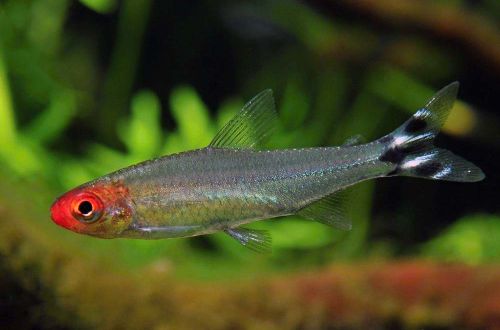
Somik knutohvost
Acestridium sucker catfish or whiptail catfish, scientific name Acestridium dichromum, belongs to the family Loricariidae (Mail catfish). A fairly new species, commercially available since the late 1990s. Most of the specimens presented are wild-caught, as breeding in the artificial environment is very difficult. Exported catfish are often emaciated and poorly acclimatized to the aquarium, so they are not recommended for beginner aquarists.

Contents
Habitat
Comes from South America. It is found in the upper and middle basins of the Orinoco River in Venezuela. Inhabits sections of rivers flowing through hilly areas overgrown with dense tropical forest. A typical biotope is a small shallow stream with rocky substrates and dense coastal vegetation.
Brief information:
- The volume of the aquarium – from 40 liters.
- Temperature – 20-28°C
- Value pH — 6.0–7.5
- Water hardness – 2–15 dGH
- Substrate type — stony
- Lighting – moderate
- Brackish water – no
- Water movement – moderate or strong
- The size of the fish is about 6 cm.
- Nutrition – plant foods, algae
- Temperament – peaceful
- Content alone or in a group
Description
Adults reach a length of about 6 cm. The fish has an elongated flattened head and body. The eyes are set far back. The caudal stalk is thin, it is crowned with a small tail, resembling the tip of a whip or whip. This feature is reflected in the aquatic name of the species – “whiptail”. The coloration is variable and depends on the external habitat, it can vary from yellow to brown/dark.
Food
In nature, it feeds on algae growing on the surface of stones, rocks or snags. In a home aquarium, the diet should be appropriate. It is recommended to use special feeds for herbivorous species and stimulate the natural growth of algae.
Maintenance and care, arrangement of the aquarium
The optimal size of the aquarium for one or two fish starts from 40 liters. When keeping, it is important to create conditions resembling a natural habitat – a stream bed with a fast current. The design uses rocky soil with heaps of stones, boulders, several natural snags and other decorative elements at the discretion of the aquarist. The presence of live aquatic plants is not necessary, if desired, it is allowed to place some hardy varieties adapted to growth in turbulent conditions.
Since whiptail Catfish originates from flowing reservoirs, it is very sensitive to the quality and hydrochemical composition of water. The aquarium must be equipped with a productive filtration system, which is also able to provide internal flow, as well as carry out regular procedures for cleaning, replacing water and removing organic waste.
Behavior and Compatibility
Peaceful calm fish, compatible with other non-aggressive species of comparable size, which will not consider it as prey. Able to live both alone and in a group.
Breeding / breeding
At the time of writing, no successful cases of breeding in home aquaria have been recorded.
Fish diseases
The cause of most diseases is unsuitable conditions of detention. A stable habitat will be the key to successful keeping. In the event of symptoms of the disease, first of all, the quality of the water should be checked and, if deviations are found, measures should be taken to correct the situation. If symptoms persist or even worsen, medical treatment will be required. Read more about symptoms and treatments in the Aquarium Fish Diseases section.





